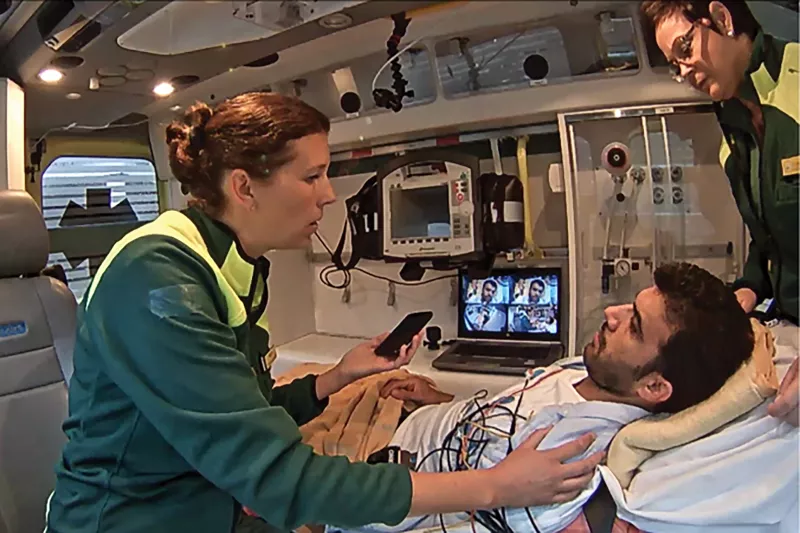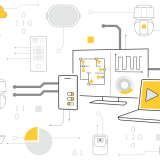
Network cameras enable ambulances to provide the right care faster.
Cloud-based camera solution gives support to paramedics.
Mission
When a person has a stroke, getting the right care in time is crucial. Pre-hospital ICT Arena at Lindholmen Science Park (PICTA), in partnership with Sahlgrenska University Hospital, University of Borås, Ambulanssjukvården i Västra Götalandsregionen [Emergency Medical Services in Region Västra Götaland] and Chalmers University of Technology, wanted to find new ways for stroke patients to receive the appropriate care more quickly.
Solution
Axis network cameras, coupled with the cloud-based solution AXIS Companion, designed for smaller installations, are installed in ambulances in Region Västra Götaland. This enables the ambulance crew to receive support from neurological experts through video consultation so they could assess patients’ conditions more accurately and decide whether they should be transported to the nearest local hospital or to a hospital with specialist care. This means the right care can be provided as quickly as possible. Wireless communication between the ambulance and hospital is handled via 4G with a modem designed for mobile use.
Result
The solution was tested in full-scale simulations and installed for live initial clinical testing. In the simulations, the network video solution was shown to give the hospital staff a greater opportunity to diagnose patients correctly as soon as they were in the ambulance. Quicker assessment and treatment of a stroke save lives and reduces the potential negative after-effects, which can be life-long. They also give stroke survivors a better chance of living a highfunctioning life, while at the same time creating greater health-economic benefits for society at lower costs.
Better and faster care saves lives
When a person has a stroke, getting the right care in time is crucial. In Sweden, more than 25,000 people suffer from acute strokes each year. Though it mainly affects older people, younger people can also be affected. A stroke is the somatic affliction that puts the greatest burden on hospitals and society with the highest costs and the greatest number of care days. Many of those who survive a stroke suffer life-long after-effects and, at worst, need permanent care in sheltered housing.
“Some stroke patients can receive treatment that restores them to full health, provided they get the right treatment in time,” says Lars Rosengren, Professor of Neurology at Sahlgrenska University Hospital and the Chair of the Regional Stroke Council in Region Västra Götaland.
If a stroke is suspected, the standard routine is for the patient to be taken to the nearest hospital to eliminate any “blockage” in the brain using treatment to reduce blood clotting. If a scan at the time indicates a large blood clot causing blockage in a central blood vessel, the patient must be immediately transported to a university hospital in Sweden that can surgically remove the blood clot (thrombectomy). Half of all patients who receive this treatment within six hours recover completely, meaning they can live an independent life. But the effect is time-dependent – simply put, the faster the better.
In Region Västra Götaland, there is only one hospital that can perform thrombectomies – Sahlgrenska University Hospital. This treatment is given when a scan has shown a blockage (blood clot) in any of the major blood vessels of the brain. These patients are generally the ones with the greatest symptoms in terms of number and severity.
“To shorten the time to thrombectomy, it would be of great value if ambulances with potential thrombectomy cases could be routed directly to Sahlgrenska instead of the time consuming detour via the nearest hospital,” says Lars Rosengren.
Ongoing work is under way to prevent and treat strokes. Prehospital ICT Arena at Lindholmen Science Park (PICTA) is making use of technology in prehospital care processes, and has undertaken a joint venture with Sahlgrenska University Hospital, University of Borås, Ambulanssjukvården i Västra Götalandsregionen [Emergency Medical Services in Region Västra Götaland] and Chalmers University of Technology. The project focuses on finding new ways for stroke patients to receive care as soon as possible after they show symptoms.
AXIS Companion offers a quick and easy way for us to test our concept. Axis also has a reliable and knowledgeable support service, which is incredibly valuable.
Reliable solution provides support in real time
A network video solution was initially installed in a test ambulance, followed by three operational ambulances in Region Västra Götaland. Axis network cameras, coupled with the cloud-based AXIS Companion solution, designed for smaller installations, are installed in the ambulances.
Each ambulance has three fixed-mount network cameras. One camera is positioned so it can film the patient’s entire body from the feet upwards. A second is positioned to get close-ups of the patient’s face, while a third provides a side view and an image of the paramedic performing the examination. The positioning was chosen to enable stroke doctors (vascular neurologists) at the hospital to see both the body and the face as clearly as possible when making their assessment.
Wireless communication between the ambulance crew and hospital staff is handled via 4G with a modem designed for mobile use to ensure continuous communication. The solution is easy to handle, and the ambulance crew communicates with the stroke doctor by mobile phone, which is standard practice today. Inside the ambulance, there is a tablet on which the ambulance crew can see the same video as the hospital doctor. The images are streamed in real time, but are not recorded or stored. They only serve as an extension of the telephone consultation.
The advantages of Axis network cameras include their dependability, operational reliability and stability. The image quality is high, and the cameras are easy to handle and can be accommodated in the tight space of the ambulances.
“AXIS Companion offers a quick and easy way for us to test our concept. Axis also has a reliable and knowledgeable support service, which is incredibly valuable,” says Bengt Arne Sjöqvist, Professor of Practice in Healthcare Informatics at Chalmers University of Technology and Programme Manager for PICTA at Lindholmen Science Park.
Expert knowledge to the ambulance
Real-time images via network video provides support to the ambulance crew who, together with the stroke doctor, can better examine and assess the patient’s health at that particular time.
The doctor can then make a more knowledgeable medical assessment, diagnose and determine whether the symptoms indicate a blockage in a large central blood vessel that needs to be treated with a thrombectomy. This determines which hospital the patient should be taken to, i.e. the nearest local hospital or a hospital with specialist care.
“It gives the ambulance crew a sense of security to have a specialised stroke doctor with them via a video link. In addition to the direct support in assessment, it also provides training as it helps the ambulance crew become even better at identifying and assessing a stroke,” says Bengt Arne Sjöqvist.
“It may be difficult for the ambulance crew to assess the patient’s condition correctly in order to determine whether he or she should be sent to a nearby hospital for treatment to reduce blood clotting or directly to Sahlgrenska University Hospital for a thrombectomy,” says Lars Rosengren.
The large geographical distance in some areas also makes video communication valuable as the closest university hospital may be some distance away, especially problematic when time is of the essence. “Delaying proper treatment by just one hour could be the difference between living a normal life after a stroke and developing severe damage in the brain and, worst case scenario, could lead to life-long care in sheltered housing. Video communication saves both lives and quality of life,” says Lars Rosengren.
The ambulance crew members are given special training that enables them not only to be able to interact with a stroke doctor and examine the patient, but also to benefit from the new technology and way of working. With the network video solution, hospital staff can also be better prepared when the ambulance arrives with the patient.
Great human and socio-economic benefits
Getting the right care more rapidly increases the chance of the stroke victim being able to resume a fully functioning life after the stroke. It saves lives and reduces suffering for patients and their loved ones and provides great health-economic benefits to society in the form of lower disease costs. “Society saves SEK 400,000 for each stroke patient treated with a thrombectomy if the treatment can be given in time,” says Lars Rosengren.
A future goal is to assess whether ambulances should also have a mobile camera that they can take with them to film the patient immediately on arrival at the scene, even before the patient has reached the ambulance. Then, the ultimate goal is for network video to be used in additional units and operational organisations.
“We are convinced the cameras can also be used for other types of incidences, such as for trauma patients or, with mobile cameras, to assess whether the patient can actually be left in the home or would be better managed by primary care,” says Bengt Arne Sjöqvist.
Facts about stroke
Approximately 25,000 people suffer from strokes each year in Sweden. While it mainly affects older people, younger people can also be affected. It affects women and men equally. In 85 per cent of cases, the stroke is caused by a blockage or a blood clot, referred to as an ischaemic stroke. In the other 15 per cent of the cases, it is caused by bleeding on the brain, referred to as a haemorrhagic stroke.
Worldwide, one in six people are expected to have a stroke at some point in their lifetime. Even if a person survives a stroke, as many as 30 per cent develop life-long after effects and cannot resume living their previous life. They instead need help with everything ranging from managing day to day tasks to, at worst, lifelong care in sheltered housing. (Sources: Stroke.se, MedTech West, Prehospital ICT Arena)
Products & solutions

Healthcare

Axis end-to-end solutions for surveillance
These trouble-free solutions give you the edge you need so you can focus on what matters to you. With all...
Get in touch
Want to know how you can benefit from Axis solutions? Get in touch and we will help you.
Contact us